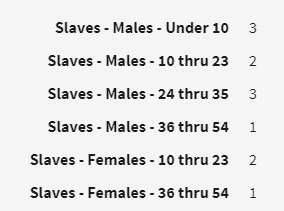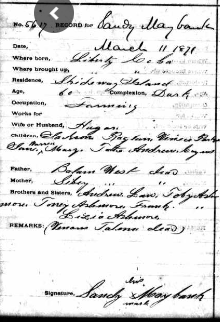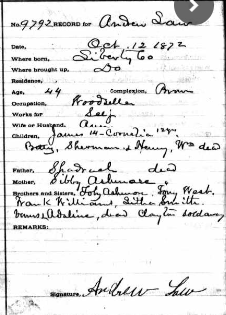Research - Sibby's Family
Enslaved People Held by John Ashmore (1767-1849)
Liberty County, Georgia
Created: 2/7/2019 by Stacy Ashmore Cole
This is the only information provided for the African American people enslaved by my 4th great-grandfather John Ashmore (1767-1849) in the 1840 U.S. Federal Census:

Through research in online databases, we can now — 179 years later — put names to these cold statistics:
|
People enslaved by John Ashmore (1767-1849) in Liberty County, Georgia (1840) |
||
|
Men/Boys |
Names (ages) |
Name Taken at Emancipation |
|
<10 years |
Andrew (5) |
Andrew Law |
|
<10 years |
Frank (6) |
Frank Williams |
|
<10 years |
Abram (7) |
unknown |
|
10-24 years |
Clayton |
“Sold away” |
|
10-24 years |
Edwin |
unknown |
|
24-36 years |
Toney (30) |
Toney West |
|
24-36 years |
Sandy (27) |
Sandy Maybank |
|
24-36 years |
Toby (30) |
Toby Ashmore |
|
36-55 years |
Saul (44) |
Saul Jones |
|
Women/Girls |
||
|
10-14 years |
Unknown |
|
|
10-24 years |
Elitha (?) |
Elitha Smith |
|
36-55 years |
Sibby |
Sibby Ashmore or Sibby West |
What kinds of records allow us to draw these conclusions?
In 1841, John Ashmore, a white planter living in Liberty County, Georgia, wrote his will. He distributed 11 named enslaved people among his relatives. Ashmore died in late 1849.
|
John Ashmore’s will left enslaved people to these family members |
||
|
Family Member |
Enslaved Persons |
Relationship |
|
Sarah |
Abram, Andrew, Edwin, Elitha |
Sarah Rebecca Ashmore, his daughter, married Benjamin Lane |
|
Mary |
Siby, Toney, Clayton |
Mary Elizabeth Ashmore, his daughter, married to Joseph Ashmore |
|
Daniel/Mary |
Sandy, Frank |
The will left Sandy and Frank to Daniel Ashmore, his son, but a codicil noted that Daniel had been committed to the State Insane Asylum in Milledgeville, and left them to Mary upon Daniel’s death |
|
Ann |
Toby |
Ann V. Ashmore, daughter-in-law and widow of Joseph Ashmore (1791-1832) |
|
Strong |
Saul |
Strong Ashmore, his grandson |
Find this record: FamilySearch.org, “Georgia Probate Records, 1742-1990,” Liberty County, “Appraisements, bonds, and wills Vol. B 1823-1850,” p. 480, image #691, Will of John Ashmore.
(https://www.familysearch.org/ark:/61903/3:1:3QS7-893L-GH8M?i=679&wc=9SYT-PT5%3A267679901%2C268032901&cc=1999178, accessed 2/7/2019).
Transcript available at: TheyHadNames.net website, https://theyhadnames.net/2018/06/08/liberty-county-will-john-ashmore/, accessed 2/7/2019.)
On 11 March 1871, Sandy Maybank named the following as his siblings to the U.S. Freedman’s Bank: “Andrew Law, Toby Ashmore, Toney Ashmore, Frank Ashmore, Lizia Ashmore, Venus + [looks like] Talena dead.” He listed Sibby West and Balaam West, both dead, as his parents.
On 12 October 1872, Andrew Law named the following as his siblings to the U.S. Freedman’s Bank: “Toby Ashmore, Tony West, Frank Williams, Litha Smith, Venus + Adaline dead, Clayton sold away.” Sibby Ashmore and Shadrach, “deceased,” were named as his parents.
These records were the basis for understanding that most of the individuals named in John Ashmore’s will were related, and that Sibby was the mother of Andrew, Toby, Toney, Frank, Elitha (Lizia, Litha), Sandy, and Clayton. Adaline and Venus were not listed in the will, so may have been born after 1840. (In addition. Mary Elizabeth Ashmore purchased an enslaved woman named Venus and her children Betsey and Will, from planter Roswell King in 1850.)
The Freedman’s Bank records also provided clues as to the surnames these enslaved people adopted after Emancipation (even though the surnames varied between the two records), and made it possible to find them in the 1870 and 1880 censuses, which provided information on their approximate ages, allowing them to be placed on the list of age ranges in the 1840 census for the people enslaved by John Ashmore in the table above.
Saul, Abram and Edwin were not mentioned in the Freedman’s Bank records. An Abram Houston is found many times in the 1870’s and 1880’s Liberty County records, both in census and deed records, and he lived very close to Frank Williams, Toby Ashmore, and members of the white Ashmore family. [Updated: 8/22/2019] It seemed very likely that he was the Abram mentioned in the will, but further research has show this to be untrue.
[Updated: 8/22/2019] Saul was left in the 1841 will to Strong Ashmore, John Ashmore’s grandson. However, Strong Ashmore had already passed away (in 1847) when John Ashmore died in 1849. It is likely then that Saul went to Strong’s widow, Caroline Ashmore (later Caroline Coleman), who is listed in the 1850 Slave Schedule as owning 1 54-year-old man. “Saul, servant of Mr. John Ashmore” was admitted to Midway Congregational Church in the August 1859 session. (See this record here.) There were several “John Ashmores” alive at that time, but one of them was the son of Strong and Caroline Ashmore, making it very likely that he was Saul’s owner at that time. He was admitted “by certificate,” which appears to indicate that he had transferred from another church; in the 1846 Rev. Charles Colcock Jones census of African American church members, Saul, belonging to John Ashmore, attended the Methodist Pleasant Grove Church. He had been baptized into that Church in 1830. In the 1860 census John Ashmore (1835-1910) was living with relatives in Savannah, so it is possible that Saul also moved with him to Savannah. In a Southern Claims Commission petition after the Civil War, Saul Jones listed his slaveowner as James Sumner Ashmore, also a son of Strong and Caroline Ashmore, brother to John Ashmore, who died in 1865 during the Civil War. The witnesses for Saul Jones’ SCC claim were Frank Williams and Toney West.]
If Saul was that man, then Clayton and Edwin — also not found in records after the Civil War — are likely to have been the two 10-24 year old men listed in the 1840 census. Clayton is listed in the Freedman’s Bank records as having been sold “away,” probably meaning outside Liberty County. Unless an unexpected record turns up of this sale, DNA results linking descendants of this family may hold the key to finding out what happened to Clayton.
So then who was the second 10-24 year-old enslaved woman or girl mentioned in the 1840 census? Why was she not mentioned in the will? Research continues…


